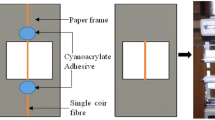Abstract
The following are common to fibre blends and CM made from them: extremal dependence of the combustion indexes of the fibre blend and CM on the ratio of fibres in the blend and large contribution of small amounts of another kind of added fibre in the reciprocal effect of the fibres on thermooxidative degradation of the fibres constituting the blend; closeness of the combustibility indexes of the fibre blend and CM in the absence of a reciprocal effect of the fibres on the thermostability and weight loss in thermolysis of the fibre blend to the combustibility indexes of the less combustible constituents; lower combustibility of CM in reinforcement with a uniform fibre blend than in layered distribution of these fibres in the blend; higher actual strength properties of CM than the calculated values.
Similar content being viewed by others
Author information
Authors and Affiliations
Rights and permissions
About this article
Cite this article
Panova, L.G., Artemenko, S.E. Physicochemical Principles for Creation of Blended Textile Materials with Low Combustibility and Hybrid Reinforced Composite Materials Made from Them. Fibre Chemistry 33, 299–305 (2001). https://doi.org/10.1023/A:1012902901008
Issue Date:
DOI: https://doi.org/10.1023/A:1012902901008




